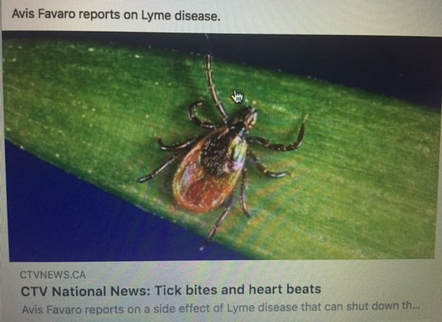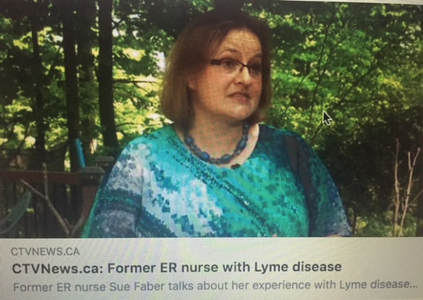Lyme Carditis - CTV National News Fantastic news coverage and story on Lyme Carditis by Health Reporter Avis Favaro from CTV National News broadcasted Wednesday May 30, 2018. https://www.ctvnews.ca/video?clipId=1406543 Print Article (copied below): https://www.ctvnews.ca/health/rare-but-serious-complication-of-lyme-disease-can-attack-the-heart-doctor-1.3952476 'A heart specialist in Kingston, Ont. is warning health care professionals across the country to be on the lookout for a rare but serious complication of Lyme disease in which the disease bacteria begin to attack the heart. The condition is called Lyme carditis and it can do serious damage by disturbing the heart’s electrical system andrate. Cardiologist Dr. Adrian Baranchuk, from the Kingston General Hospital Research Institute, says that’s why it’s so important for Canadian doctors to recognize the symptoms early and begin treatment – even before they have a definite diagnosis. Most Canadians know Lyme disease is spread by ticks carrying the bacteria. The illness those bacteria cause is marked by fever, fatigue, and joint pain as well as other symptoms. But when Lyme bacteria travel through the blood to the heart, they can also cause inflammation that disrupts the organ’s electrical system. The result is a condition called “heart block” in which the heartbeat becomes too slow. The most common symptoms are sudden dizziness, shortness of breath, and chest pain. Left untreated, the condition can rapidly progress to complete heart shutdown. Adam Flisikowski was diagnosed with Lyme carditis last summer after the previously healthy teen ended up in hospital with an erratic and dangerously slow heartbeat that dropped to 30-40 beats per minute. The 19-year-old had just returned from a camping and fishing trip near Kingston and though he had taken precautions against bug and tick bites, when he got home, he found a small tick on his heel. He removed it, but six weeks later, he began having heart symptoms. “I woke up and I could feel that something was wrong in my chest,” he told CTV News. “I felt like I was running but I was sitting down.” Doctors told the teenager he might need to be fitted with a pacemaker to normalize his heartbeat. After several tests, doctors finally diagnosed him with Lyme carditis. Dr. Baranchuk says Flisikowskiwas just one of several patients who were admitted to the Kingston Health Sciences Centre’s cardiac unit over 18 months with heart block symptoms. All were males under the age of 50 – one was just 14 – and all had recently taken part in outdoor activities. “One of the things we noticed was each one of them had attended a different ER two to three times before anyone thought about this condition,” says Dr. Baranchuk. Diagnosing Lyme carditis is often difficult because not only is the condition rare, many patients don’t get the bullseye rash caused by the bite of a Lyme-infected tick. Many also don’t notice the other, vague symptoms of Lyme disease, such as fever and muscle aches, which are often mistaken for the flu. With Lyme diagnoses on the rise and the deer ticks that spread Lyme being found in parts of the country, Dr. Baranchuck worries Lyme carditis cases are going to increase but get missed. “We have the suspicion that there are way more cases than are reported, because doctors are failing to report it,” he said. That’s why Dr. Baranchuk has just published a paper advising Canadian health care workers to treat young patients with unusual heart problems with antibiotics to kill off any Lyme bacteria that might be present, while they wait for blood tests to confirm Lyme infection. “These patients may not require pacemakers to be implanted. They can be treated with IV antibiotics for 10 to 12 days and the electricity of the heart will recover completely forever,” he said. As for Flisikowski, because Dr. Baranchuk was able to offer him a quick diagnosis, he received antibiotics in time and his heart has now recovered. “I am doing pretty good now. I am back to normal, I can do normal activities,” he said, fully aware his story is now a cautionary tale. Sue Faber, a former ER nurse who had Lyme disease and now works with Lyme Hope, said that when patients present with symptoms such as fever, fatigue and joint pain, Lyme disease should be on top of mind among possible diagnoses, even when there is no rash present. “We can treat them with antibiotics and they can go on with their lives,” she said. The Ontario government says the best way to prevent Lyme disease is to prevent tick bites by: covering up
Dr Adrian Baranchuk: Cardiologist Meet Dr Adrian Baranchuk, Cardiologist extraordinaire from Queens University. I've had several opportunities to talk with Dr Baranchuk and appreciate his dedication to his profession and sharing his expertise in a way which will undoubtedly help Canadians! 'One of the things we noticed was each one of them had attended a different ER two to three times before anyone thought about this condition,” says Dr. Baranchuk. Diagnosing Lyme carditis is often difficult because not only is the condition rare, many patients don’t get the bullseye rash caused by the bite of a Lyme-infected tick. Many also don’t notice the other, vague symptoms of Lyme disease, such as fever and muscle aches, which are often mistaken for the flu.' We also appreciate that Dr Baranchuk took the time to share his research at the recent MP round table in Ottawa on Lyme disease! Fantastic collaboration! Dr Baranchuk's full CTV interview here: https://www.ctvnews.ca/video?clipId=1406334 His publication in the CMAJ on Lyme Carditis: http://www.cmaj.ca/content/190/20/E622 Recent article on Dr Baranchuk's work at Queens: https://www.queensu.ca/gazette/stories/new-hope-lyme-disease-battle Adam Flisikowski - Diagnosed with Lyme Carditis Meet Adam Flisikowski - 19-year old shares his experiences with Lyme Carditis. He discusses taking preventative measures before he went on a camping and fishing trip - he was wearing long sleeves and socks over his pants. At first he thought it was soil, a speck on his foot - but it was stuck on, very small. It was a small tick. 6 weeks after the bite, his heart started racing, felt that something was wrong in his chest.. 'The 19-year-old had just returned from a camping and fishing trip near Kingston and though he had taken precautions against bug and tick bites, when he got home, he found a small tick on his heel. He removed it, but six weeks later, he began having heart symptoms. “I woke up and I could feel that something was wrong in my chest,” he told CTV News. “I felt like I was running but I was sitting down." Doctors told the teenager he might need to be fitted with a pacemaker to normalize his heartbeat. After several tests, doctors finally diagnosed him with Lyme carditis.' He hopes his story can highlight the Importance of everyone being aware of this serious issue. No one knew right away that it was Lyme disease, Lyme carditis... Adam's interview here: https://www.ctvnews.ca/video?clipId=1406436 Sue Faber: Registered Nurse Meet Sue Faber, Registered Nurse, co-founder of LymeHope and discussing the importance for frontline healthcare professionals to be aware of Lyme disease as a differential diagnosis - not all patients have a rash, not all patients remember a tick bite! We need to educate on the diversity of acute and chronic lyme disease presentations and continue working in collaboration to spread the word and help more Canadians! Education on Lyme carditis must be a collaborative, multi-disciplinary approach which engages medical and scientific experts along with patients - who know first hand the disease they suffer with. Evidence-based medicine is anchored in this approach and we will continue to make strides forward as we work together to educate and engage with frontline healthcare professionals - with the patient experience and narrative as an important focus. Thankful for Dr Adrian Baranchuk from Queens University pioneering this important work - for his dedication and research on Lyme Carditis - spreading the word and educating other healthcare professionals! Sue's CTV interview here:https://www.ctvnews.ca/video?clipId=1406270 Recent Registered Nurses Association of Ontario resolution on Lyme disease: co-authored by Sue - speaking to the importance of Patient First Treatment of Canadians with Lyme disease: http://www.lymehope.ca/news-and-updates/registered-nurses-association-of-ontario-resolution-on-lyme-disease
49 Comments
Of 400 ticks collected, 98% were black legged ticks which can transmit Lyme disease Photo of Dr Vett Lloyd and colleagues Courtesy of CBC Photo of Dr Vett Lloyd and colleagues Courtesy of CBC Excellent article by CBC about Lyme disease carrying ticks on PEI and the research of Dr Vett Lloyd from Mt Alison University. Dr Lloyd is a Lead Researcher of the Canadian Lyme Consortium (CLC) - a Canadian research network focused on Lyme disease with a model of patient-research-clinician engagement at all levels for all projects by conducting meaningful science and investigating questions that matter to patients and matter to the healthcare professionals who treat patients - see more info on the Canadian Lyme Consortium (CLC) in link below. Many Canadians chose PEI as their summer destination of choice and so this information is vitally important to be aware. 'Lloyd says more than 80 per cent had been picked up on Prince Edward Island, from people who hadn't travelled off the Island. The vast majority, she said, were the black legged ticks, formerly known as deer ticks, which can transmit Lyme disease.' 'The lab also tested blood samples from dogs across the Island. Lloyd said seven were infected with the Lyme disease bacteria and six of those had never left the Island.' Please also join almost 62000 Canadians in signing, commenting and sharing our Canadian Lyme Petition and issues around Lyme disease and the obstacles and road-blocks faced by Canadian sufferers need to be dismantled. Canadians who are currently sick with Lyme disease need recognition, treatment and support. Canadians who are concerned about Lyme disease need the appropriate tools, up-to-date treatment guidelines and resources to best deal with when they encounter a tick - whether it be the school-yard, golf course or back-yard. https://www.change.org/p/minister-petitpas-taylor-ticking-lyme-bomb-in-canada-fix-canada-s-lyme-action-plan-now More information on the Canadian Lyme Consortium (CLC) here: http://www.lymehope.ca/advocacy-updates/patient-first-research-patient-first-engagement-patient-first-values-and-preferences-patient-questions-making-an-informed-choice Patient First Treatment for Ontarians with Lyme Disease - RNAO Resolution The Registered Nurses Association of Ontario (RNAO) voted through a resolution on Lyme disease 'Patient First Treatment for Ontarians with Lyme Disease' at their annual AGM conference in Toronto on Friday April 20th, 2018. A live recording of the resolution process and vote below. Please note, the Lyme resolution is the very first one addressed. https://www.facebook.com/RNAOHomeOffice/videos/10151012128169944/ **please note, 2 minor amendments were made to the below resolution adding in prevention programs for Lyme disease and strengthening some of the language used. We will update the resolution to reflect the changes with these amendments as soon as possible. Patient First Treatment for Ontarians with Lyme Disease Submitted on behalf of Halton Chapter Author: Sue Faber and co-authors: Catherine Kinsella, and Louela Manankil-Rankin. Authors declare no conflict of interest. Resolution: WHEREAS people with Lyme disease and/or co-infections in Ontario are not consistently receiving appropriate diagnosis and treatment of these diseases due to inadequate testing protocols and a lack of up to date education of medical professionals on the clinical diagnosis of these diseases; WHEREAS there is a lack of education and awareness regarding persistence of infection, transplacental transmission, co-infections, other possible modes of transmission (sexual, blood supply, needle sticks, organ donation and other insect vectors), symptoms (acute vs. chronic), surveillance of chronic cases, modes of testing, treatment, and the existence of up to date, evidence-based guidelines published by ILADS; WHEREAS these challenges along with the politicization of this disease has created fear and uncertainty amongst healthcare professionals thereby forcing patients with Lyme disease and/or co-infections to pay for out of Country testing and seek health care outside of Canada at their own expense; THEREFORE be it resolved that the Registered Nurses’ Association of Ontario (RNAO) advocate, at all levels of government, for the rights of all patients with symptoms consistent with Lyme and/or co-Infections to receive fair and proper treatment for both acute and multi-systemic chronic presentations of the disease in Canada; emphasizing healthcare provider education that acknowledges alternate modes of transmission, persistence of infection, and integration of a collaborative clinical model inclusive of ILADS guidelines in the treatment of this illness. Background: Lyme Disease is a serious and rapidly growing public health crisis in North America, caused by the bacterium Borrelia burgdorferi. It is spread by ticks that are carried by migratory birds and animals such as deer and mice. In 2016, there were an estimated 178,000 cases in US States bordering Ontario (Centers for Disease Control and Prevention, 2017). Canadian scientists predict that by the year 2020, 80% of the population of Eastern Canada will be living in a tick-populated area (Leighton, 2012). Limitations of current testing (Health Canada, 2012) and treatment protocols have left thousands of Canadians improperly diagnosed and inadequately treated for the disease. Many have been forced to seek treatment outside of Canada at their own expense resulting in financial hardship, significant stress and strain on families (Boudreau, Lloyd, Gould, 2017). Bill C442 was passed in 2014 with a mandate of creating a national strategy for Lyme Disease, embracing a collaborative process of all stakeholders including patients (Bill C442, 2014). In May 2017, the Federal Framework for Lyme Disease was released (Public Health Agency of Canada, 2017). In June 2017, the House of Commons Standing Committee on Health called for a study of the Federal Lyme Framework (HESA, 2017). Canadian patients, advocates, nurses, treating physicians, scientists, and researchers agree that the Lyme Framework failed its mandate and is insufficient to drive meaningful patient-centered change in Canada (HESA, 2017). It neglects to acknowledge the vast body of peer reviewed literature which documents persistence of infection resulting in chronic Lyme disease (International Lyme and Associated Diseases Society [ILADS], 2015) as well as clear evidence of vertical transmission from mother to child in utero (LymeHope, 2017). It is silent to voiced concerns over other possible modes of transmission (sexual, blood supply, needle sticks, organ donation and other insect vectors). Alternate testing options are not addressed, it does not adequately address co-infections that may accompany Lyme disease and does not address treatment guidelines for chronic Lyme disease. In a collective response to the failed framework, in August 2017, a petition with over 52000 names (Canadians Concerned About Lyme Disease, 2017), 14000 comments and 2700 personal letters from Lyme patients (Lyme Letters Canada, 2017) and their families were handed to the Federal Minister of Health and Chief Public Health Officer of Canada (Kingston, 2017). Patients have an important role to play through personal and public advocacy by presenting their lived experience to health professionals and decision makers including politicians at all levels of government (Federal Lyme Conference Patient Testimonies, 2017). Patients have the right to timely and appropriate clinical diagnosis and treatment of Lyme disease and all co-infections utilizing evidence-based and up to date guidelines developed by specialist bodies that include ILADS. The ILADS guidelines are currently the only guidelines endorsed and listed on the National Guidelines Clearinghouse that must meet the U.S. Institute of Medicine (IOM) standard for the development of clinical practice guidelines (NGC, 2014). Evidence based practice obliges practitioners to respect patients’ values and preferences alongside clinical judgment and relevant scientific evidence (DiCenso, Gordon, Ciliska, 2005). Nurses have a critical role to play in education, facilitating awareness, early detection and patient advocacy in areas such as Public Health, Emergency Rooms, Physician and Nurse Practitioner offices, summer camps and through policy change. Education has the ability to lift the veil of uncertainty surrounding Lyme disease for both patients and healthcare professionals and to bridge the gaps that currently exist, enabling early diagnosis and appropriate patient-centered treatment. References
**Please note, 2 minor amendments were made but have not yet been updated to this resolution adding in education/prevention programs for Lyme disease and strengthening some of the language used. |
AuthorWrite something about yourself. No need to be fancy, just an overview. Archives
November 2022
Categories |
